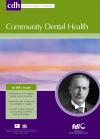Community Dental Health

- Cover Date:
- September 2009
- Print ISSN:
- 0265 539X
- Vol:
- 26
- Issue:
- 3
Consent of older children participating in BASCD coordinated dental epidemiology surveys in Wales.
New guidance on consent for England and Wales, which has positive consent at its core, has implications for the UK-wide BASCD coordinated dental epidemiology programme. This paper describes a method used in Wales for obtaining consent from older children which is believed to comply with the new guidance. Objective The objective was to establish a more robust approach to gaining consent from 12 and 14 year olds taking part in the surveys, by building on existing “negative consent†practice and supplementing it with Gillick competent child consent. Design and setting Questionnaire data from the 2002-03 survey of 6,393 13-14 year-old children and the 2004-05 survey of 6,749 11-12 year olds were used in this analysis. Questions specifically designed to establish competency to consent were asked of participating children. These ascertained whether children were happy to proceed and if so, whether they understood the nature and the purpose of the survey and whether they were happy with the outcome. Results Ninety-nine percent of those taking part in both survey years were happy to proceed with the examination and questionnaire. Whilst the majority of children, agreeing to take part, indicated that they had understood what was proposed and were happy with the outcome, approximately 15% of these age groups gave answers after the event which indicated that they had not understood either the nature or purpose of the survey. Conclusion Use of “Gillick competent†consent in Wales did not affect participation rates adversely. The authors would suggest that indication of assent as used in Wales in these two surveys is appropriate and would only exclude 1% of children. The alternative, of examining only those children who answered questions on whether they understood the nature and purpose of what is proposed prior to assenting, would exclude 15% of children.
Key words: Consent, dental surveys, epidemiology
- Article Price
- £15.00
- Institution Article Price
- £
- Page Start
- 157
- Page End
- 161
- Authors
- N. Monaghan, M.Z. Morgan
Articles from this issue
- Title
- Pg. Start
- Pg. End
- The fractional urinary fluoride excretion of adults consuming naturally and artificially fluoridated water and the influence of water hardness: A randomized trial.
- 132
- 137
- The prevalence and severity of dental fluorosis in the high and low altitude parts of Central Plateau, Nigeria
- 138
- 142
- Prevalence of enamel defects related to pre-, peri- and postnatal factors in a Brazilian population.
- 143
- 149
- Development of a psychometric scale to assess satisfaction with dental care among Sri Lankans
- 150
- 156
- Consent of older children participating in BASCD coordinated dental epidemiology surveys in Wales.
- 157
- 161
- A comparison of Personal Dental Service (PDS) and General Dental Service (GDS) patients in terms of reported interventions, oral health and dentists’ perceptions
- 170
- 176
- Hopelessness, depression and oral health concerns reported by community dwelling older Australians
- 177
- 182
- Higher-order exploratory factor analysis of the Dental Subscale of Children’s Fear Survey Schedule in a Taiwanese population.
- 183
- 187
